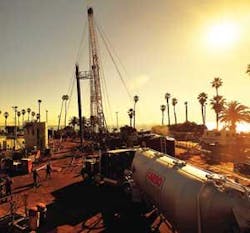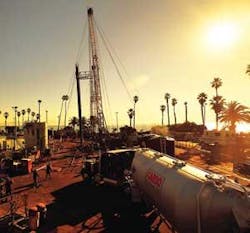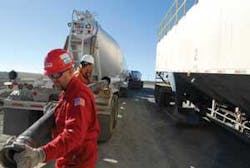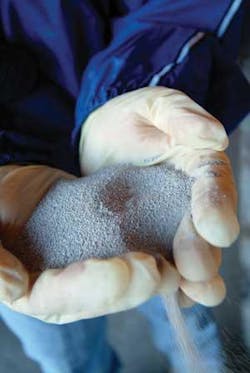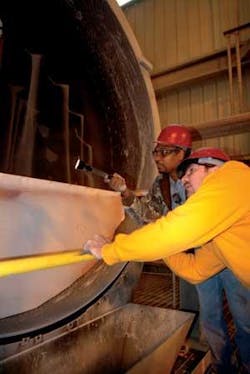Don Stowers, Editor, OGFJ
AN INTERVIEW WITH GARY KOLSTAD, PRESIDENT AND CEO OF CARBO CERAMICS
EDITOR’S NOTE: Business is booming for CARBO Ceramics, which helps energy companies enhance the productivity and financial performance of new and existing oil and gas wells around the globe. Currently demand for its ceramic proppants, which are widely used in fracturing, exceeds its capacity domestically, and the company is expanding its manufacturing facilities to keep up. Gary Kolstad, president and CEO of CARBO Ceramics, joined the company in June 2006 and much company growth has occurred on his watch. Gary has more than 20 years’ experience in the oilfield service industry, mostly recently with Schlumberger Oilfield Services, and holds a degree in petroleum engineering from the Montana School of Mineral Science & Technology. He recently spoke with OGFJ Editor Don Stowers.
Oil & Gas Financial Journal: CARBO Ceramics is a major producer and supplier of environmentally-friendly, high conductivity ceramic proppants for use in hydraulic fracturing and also provides fracture design software and fracture consulting services to the global oil and gas industry. How have the economic recession and low oil and gas prices affected your business to date and what is the outlook for 2009?
GARY KOLSTAD: CARBO had a record year (2008) in all three segments of our oilfield business. We are the world’s largest supplier of ceramic proppants, provider of the world’s most popular fracture simulation software, and are a leading provider of fracture design, engineering and consulting services. The growing awareness of the benefits of using ceramics instead of conventional sand-based products, the increase in fracturing of horizontal laterals, and the spectacular results seen when employing our products in resource plays such as the Haynesville, Bakken, and Motney continue to drive high demand.
The challenges associated with the financial crisis in the second half of 2008 and the ensuing knock-on effect to the economy, exasperated by the precipitous drop in hydrocarbon prices, have had an effect on budgets and activities of E&P companies for 2009. CARBO is not immune. However, we have seen from the industry an affinity toward the philosophy of “Economic Conductivity.” The operators believe that in targeted reservoirs, they see 15% production increase and 20% rise in estimated ultimate recovery (EUR). In many cases it’s a no-brainer investment decision. Our mission is to educate companies on the value of conductivity, and we are succeeding. We have presented technical papers at dozens of conferences in recent years, and 2008 was a watershed year for us.
OGFJ: It appears, short-term at least, that the market for natural gas and oil is contracting a bit as demand slackens. Drilling budgets have been slashed, especially in the US How will CARBO compensate for this?
KOLSTAD: CARBO does not traditionally hit the “highest highs or the lowest lows” during industry cycles. In many reservoirs, operators will lean towards ceramics in uncertain price environments due to the favorable economic results that they derive from its use. We will continue to pursue concepts that drive cost out of our supply chain, while preserving the quality of the CARBO products. In addition, we believe that any downturn in drilling will be relatively short in duration primarily due to the steep decline curves in reservoirs currently producing the bulk of US natural gas.
OGFJ: What are your various business segments — manufactured products, software, technical services, etc.? Approximately what percentage of your revenue comes from the petroleum industry?
KOLSTAD: We essentially have four business segments under the corporate CARBO umbrella, three of them directly involved in the petroleum industry: CARBO Ceramics, the leading global producer and supplier of ceramic proppant for fracture stimulation; our consulting group, tight reservoir experts who protect the client’s investment; and our software group, provider of the world’s most advanced and popular fracture modeling software, FracproPT. All of these groups are focused on one thing — to improve production rates.
OGFJ: How much of your current business is domestic (US) and how much is international? Do you expect most future growth to be domestic or overseas?
KOLSTAD: At present, about 80% of our business is in North America. Canada and the United States are well-developed frac markets — companies are well educated about this. However, as time goes by, we expect our international markets will expand as fracturing becomes more commonplace globally.
CARBO recognized the opportunities to expand overseas when we built our first international ceramic plant in Louyang, China, in 2002. Since then we have expanded its capacity and commissioned a new plant in Kopesyk, Russia. The vast majority of our business currently resides in North America since most of our commercial activities are directly tied to the hydraulic fracturing industry. However, we sold products and services in more than 40 countries last year. We intend to continue our growth and expansion overseas, assisting our E&P clients by optimizing their productive capacity and maximizing their returns.
OGFJ: Where are your manufacturing plants and other major facilities located?
KOLSTAD: We own and operate six ceramic manufacturing plants around the globe. Four are in the US (Toomsboro and McIntyre, Georgia; Eufaula, Alabama; and New Iberia, Louisiana) along with the facility in Luoyang, China, and our most recent addition in Kopesyk, Russia. Our R&D and administrative activities are managed from New Iberia. Later this year, we will re-locate our corporate headquarters from Irving (Texas) in the Dallas-Fort worth area to Houston. The New Iberia manufacturing facility was just recently re-opened specifically to supply proppant to the Haynesville shale, and during the first half of 2010 we’ll add about 20% to our overall proppant production capacity when we open a third line at our Toomsboro complex.
OGFJ: What are the circumstances that prompted CARBO Ceramics to build a manufacturing plant in Russia? Does the company have a lot of business in that region?
KOLSTAD: Prior to building the plant, CARBO worked closely with the Russian E&P operators to understand the benefits of using high-quality ceramic proppant in their oil wells. They subsequently realized tremendous success when using our ceramics in their fields, as production improved significantly due to the increase in conductivity of the fractures. Because of this effort and other successes in Russia, and recognizing the potential and significant need for high-quality ceramics in Russia, we felt that the only way to successfully compete there would be to manufacture proppant in-country. We see enormous potential not only in the oil-bearing reservoirs, but also in the future of tight gas exploitation.
OGFJ: What do you see as the major growth areas (geographically) for CARBO Ceramics?
KOLSTAD: We prefer to characterize our growth opportunities in terms of the types of reservoirs that can benefit from optimized hydraulic fracturing activities. During the past few years, our industry has reaped the benefits of increased conductivity and bolstered EUR by employing ceramics in an increasing number of resource plays. These include the Bakken, Haynesville, Woodford, Deep Barnett, and Motney — just to name a few. In large part, this has driven the demand for our products. We see this pattern continuing and expanding globally as more resource type plays are discovered and exploited.
OGFJ: CARBO Ceramics consistently talks about its employees as being the source of the company’s success. How many people do you employ (US and abroad) and what is your secret for hiring and retaining high-caliber employees?
KOLSTAD: Our success in recruiting and retaining high-caliber employees stems from our culture. We are uniquely positioned — we offer employees an entrepreneurial experience in a financially strong company. People join CARBO because it’s an exciting, high growth environment; we have a commitment to technology; we pay for performance; we have leadership positions in the businesses that we operate; we have a financial position that allows us to invest in new opportunities; and there’s little bureaucracy.
People stay with CARBO because of our culture and the respect we have for each other. We celebrate our successes and give thanks and praise where it’s due. Our positive environment builds upon itself and challenges each one of us to continuously improve. Throughout the organization, CARBO employees express a deep appreciation for being part of the team.
OGFJ: The company is listed on the New York Stock Exchange. When did CARBO go public?
KOLSTAD: CARBO had its initial public offering of stock on the NASDAQ market in 1996 and moved to the NYSE in 2000.
“We have a very strong financial position with more than $100 million in cash and no debt…we are well positioned to take advantage of investment opportunities that may present themselves in a difficult 2009 market environment.”
OGFJ: Like a number of companies operating in the oil and gas industry, CARBO Ceramics has enjoyed good revenue growth in recent years. Unfortunately for some operators, particularly those that have taken on a lot of debt in their desire to grow larger, cash flow is down and so is their stock value. What is the situation with CARBO — does the company have a strong balance sheet?
KOLSTAD: Our business is pretty much a strong cash producer. We have a very strong financial position with more than $100 million in cash and no debt. Our company has been solidly profitable throughout its history and across the inevitable cycles experienced in the petroleum industry. And we are well positioned to take advantage of investment opportunities that may present themselves in a difficult 2009 market environment. Our strong financial position allows us the flexibility to explore opportunities to grow our business through acquisition.
OGFJ: I won’t ask you if you think your stock is undervalued because I know what everybody’s answer is to that question. It’s pretty clear that oil company stocks in general are undervalued in today’s market. However, I will ask what your plans are to increase stock value during this downturn and position your company for future growth.
KOLSTAD: When joining the company, a couple of initiatives I wanted to achieve were to increase our technology innovation and bring new products to the market. We have focused and narrowed our R&D efforts, and tried to incorporate our client’s technical needs into our product development. The best value creation example of this was our launch of CARBOHYDROPROP into the market in 2008. It has brought economic value to both our clients and CARBO.
We also have been increasing our stock dividend, and given our strong cash position, the board of directors recently authorized a two million share stock buyback. We will continue to add manufacturing capacity and are also looking for acquisitions that could add value.
OGFJ: You recently brought on a new chief financial officer, Ernesto Bautista, to succeed Paul Vitek, who has retired. What will be the main concerns that the new CFO will have to address?
KOLSTAD: For more than 20 years, Paul has been instrumental in growing this company and transforming it from a privately-held company to a New York Stock Exchange-listed company with one of the industry’s strongest financial positions. He will be missed, but he helped orchestrate a seamless transition with his replacement. Ernesto brings a vast amount of proven industry experience to the job. Most recently, he served as vice president and CFO of W-H Energy Services in Houston. He attended Rice University where he earned undergraduate degrees in economics, psychology, and managerial studies, and a master of accountancy degree.
CARBO has traditionally been a financially strong company. During the past three years, we have expanded our global manufacturing capacity by 70%, all internally funded. We do not have any debt, we have more than $100 million in the bank and we continue to generate cash each quarter. One of Ernesto’s challenges will be to help us figure out where to invest the excess cash.
OGFJ: Gary, you were named President and CEO of CARBO in 2006. What do you see as the primary obstacles you will have to overcome to achieve your goals for the company and how will you accomplish this?
KOLSTAD: The cyclical nature of our industry will no doubt bring challenges, but we do not view these as barriers. We have an intelligent, motivated work force that enjoys challenges. When you combine our industry-leading technology with our motivated professionals, it produces increased profits for our customers and CARBO. We must remain committed to having the best people and innovative technology.
OGFJ: What achievement are you proudest of since you took over the reins of CARBO Ceramics nearly three years ago?
KOLSTAD: There are several achievements I am proud of:
- We have fine-tuned our focus on clients and finding ways to help them. Our people understand that our main mission is to improve production and recovery rates in oil and natural gas reservoirs.
- The introduction of CARBOHYDROPROP has brought significant value to our clients, especially in slickwater frac operations.
- We have strengthened an already debt-free balance sheet, which allows us to weather any cyclical downturn and gives us flexibility to seize opportunities.
- Our people are personally committed to quality everywhere, worldwide.
OGFJ: Gary, thanks very much for taking the time to talk with us today.
